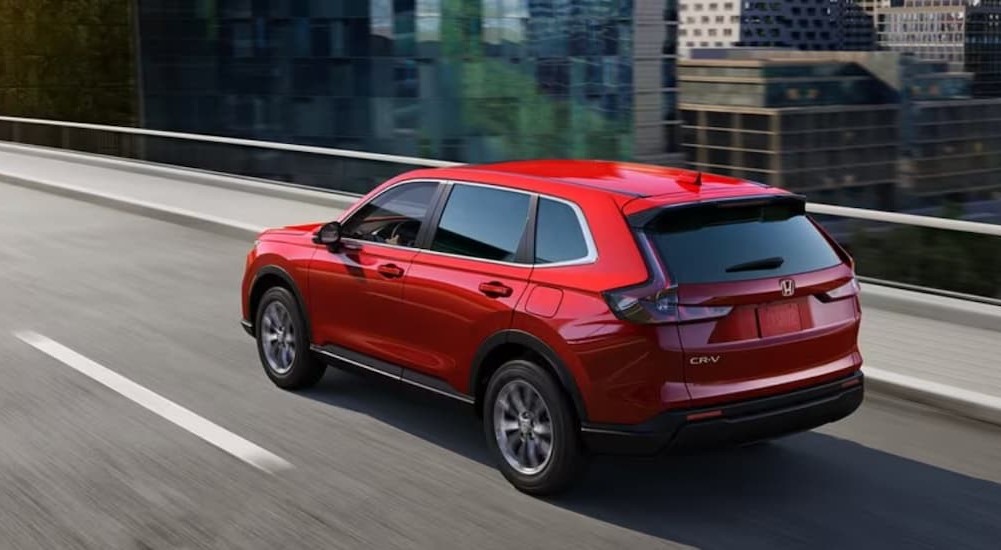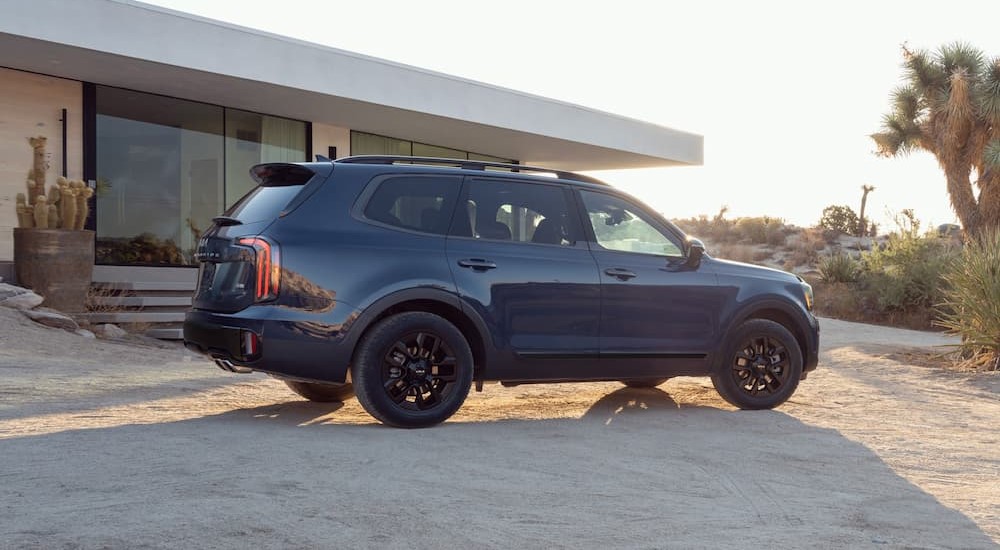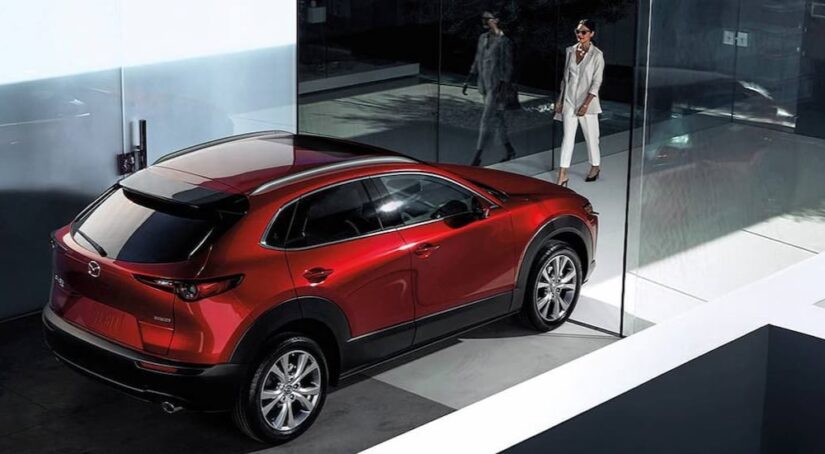A new year means a fresh new slate of cars, trucks, and SUVs, and 2024 is no different. From returning favorites to enticing new options — including a record number of hybrid and EV models — there’s a lot to get excited about as we look forward to the coming model year. Driven by the rise of crossover models, the SUV segment has continued to be a particularly popular choice for drivers of all stripes. From sport subcompacts and ultra-efficient compact models to three-row mid-sizes with room for the whole family, few segments are quite as versatile.
That said, the selection can be almost overwhelming at times, with almost every automaker offering a full lineup of SUV models. So, how do you separate the wheat from the chaff? Leave it to us. We’ve compiled three of the best SUV buys for 2024 and outlined the unique benefits of each model in a bid to make finding your next vehicle easier than ever.
The 2024 Mazda CX-30
Subcompact SUVs occupy a unique place in the market. Their small size means they can offer the driving dynamics of a sporty car, which is a significantly different experience than you’d find on the larger, full-size end of the SUV spectrum. Sure, they might not make passenger or cargo space a priority, but they’re not totally devoid of utility. If you’re the type of driver struggling to make the jump to the SUV segment, subcompacts can be a great stepping stone that allows you to up the practicality while retaining much of the fun.
When striking this balance between athletic performance and utility, few models fare quite as well as the 2024 Mazda CX-30. Based on the iconic Mazda 3 compact, the CX-30 embodies the car’s fun-to-drive spirit. Much of that reputation comes down to the engine, though it all depends on which model you choose. The non-turbo trims are powered by a 2.5-liter, four-cylinder engine that churns out 191 hp that’ll get you from zero to 60 mph in 8.1 seconds, but the turbo models are a different story altogether. The addition of a little forced induction sees the same 2.5-liter engine turbocharged to produce 30 percent more power — 250 hp to the non-turbo’s 191 hp — while cutting the zero-to-60-mph time by some 2.3 seconds.
No matter which engine you end up with, it’ll be paired with a six-speed automatic transmission. This might sound a bit limiting for those who like to choose their own gears, but Mazda has engineered around that problem with the inclusion of a manual shift mode that allows drivers to select their preferred gear while retaining all the benefits of an automatic setup. The CX-30’s relatively low center of gravity, responsive steering, and Mazda 3-inspired design make it a pleasure to drive while offering more stability than one might expect from the SUV segment.
But the CX-30 isn’t just about performance. The subcompact is also surprisingly well-appointed for an entry-level model, where the top trim still retails for less than $40,000. Again, the Mazda 3 influence is on full display, with the SUV’s interior sharing no shortage of elements with the best-selling car. Maturely and thoughtfully crafted, the interior boasts an 8.8-inch screen — 10.3 inches on the Turbo trims — that’s controlled by a rotary knob located on the center console. It might sound like a relatively minor design choice, but in allowing drivers to manipulate the infotainment display without stretching their arm out to the dashboard, the system does provide some significant ergonomic benefits.
An available eight or twelve-speaker audio system and available heated front seats up the luxury factor on the lower trims, but for just $33,000 and up, drivers can make the jump the Premium models where leather upholstery, a power-operated rear liftgate and more allow the CX-30 to punch well above its weight. The subcompact is also a real standout when it comes to safety, offering a bevy of standard driver-assistance features, including Lane-Keep Assist, Lane Departure Warning, Mazda Radar Cruise Control, and Blind Spot Monitoring.

The 2024 Honda CR-V
As a brand known for its affordability and reliability, it’s little surprise to see a Honda model end up on our list of best SUV buys for 2024. In production since 1995, the Honda CR-V has long been the compact SUV against which all other models are measured, and that doesn’t look to be changing in 2024. The CR-V has been feted with almost every award in automotive media, with recent accolades including a 10 Best Trucks and SUVs trophy from Car and Driver and landing the top spot in Kelley Blue Book’s rankings of the best compact SUVs.
So, what makes the CR-V such a good buy? It largely comes down to reputation. Honda vehicles are known for their reliability and low cost of ownership, with an average 10-year maintenance cost of less than $8,000. That puts Honda third in the overall cost of ownership rankings, which is an important stat to consider when shopping for any vehicle.
Positioned between the subcompact HR-V and midsize Pilot, the CR-V should be just right for drivers seeking a reliable family vehicle that offers the best in modern tech features without ever skimping on performance. Drivers can choose between a 7-inch display on the LX, EX, and Sport trims or upgrade to the EX-L or Sport Touring for a larger 9-inch screen. Apple CarPlay and Android Auto make an expected appearance, but the CR-V does have some unique tricks in store, including a new 7-inch digital gauge cluster with an analog speedometer that gives users the ability to display whatever driving-related information is most relevant to them.
Two USB-C ports and a wireless charger offer lightning-fast power for tablets and smartphones, while newly redesigned seats maximize comfort for front-seat passengers. There’s not one feature that really blows you away when you step into the cabin of the CR-V. Rather, it’s a subtle mix of elements that come together to form a cohesive cabin that prioritizes comfort and convenience.
Speaking of convenience, the CR-V packs one novel feature that makes the compact SUV an even better choice for busy families: an adjustable cargo floor. The CR-V’s rear cargo area measures around 36 cu.ft. with the cargo floor in its normal position, but it can also be lowered to increase the overall cargo space to 39 cu.ft. That might not sound like a major upgrade, but the space itself isn’t the point; it’s how it’s used.
Any busy parent knows the frustration of opening the trunk only to be met with an avalanche of sports equipment, groceries, toys, and the like, but the CR-V fixes all of that by allowing the cargo floor to be adjusted to a lower position, creating a lip at the rear opening that should go a long way in preventing such spillage. It might be subtle, but it should go a long way in reducing frustration and improving the overall ownership experience.
Performance-wise, the CR-V is powered by a 1.5-liter, 190-horsepower turbocharged inline-four that provides a peppy ride despite its smaller size. The subcompact also comes in a hybrid form for 2024, with a 204-hp powertrain that pairs two electric motors with the gas engine in an effort to maximize efficiency and maximize it does. The gas-powered CR-V is certainly no slouch, with 28 MPG in the city and 34 MPG on the highway to its name, but the hybrid takes it to the next level, especially when it comes to driving around town. The front-wheel drive Sport Hybrid trim posts an impressive 36 MPG on the highway, but in the city, that number can climb as high as 43 MPG. That’s a difficult number to beat and one that should guarantee the CR-V best-seller status for years to come.

The 2024 Kia Telluride
Safety, affordability, and cargo/passenger space are some of the most important metrics in the SUV segment, which is why the Kia Telluride’s success comes as no surprise. With mature styling and the ability to beat almost any other midsize model in those three key areas, the Telluride has grown from segment newcomer to crowd favorite in just four years on the market. Case in point: the SUV has earned a coveted Kelley Blue Book Best Buy Award every year since its 2020 debut, making the three-row model a force to be reckoned with.
Starting at just $35,990, the Telluride is a relative bargain in the three-row segment, though the extensive trim ladder can get expensive quickly, with more than half the models retailing for over $50,000. Front-wheel drive comes standard, but we’d recommend springing for the optional all-wheel drive, which is offered on every trim. Each Telluride model is powered by a 291-hp V6 with 262 lb-ft of torque paired with an eight-speed automatic transmission. With a zero-to-60-mph time of 6.8 seconds, the Kia isn’t the speediest SUV on the market, but it does maximize its off-road potential with an available self-leveling rear air suspension and 8.4 inches of ground clearance.
The Telluride is also among the more spacious three-row SUVs, offering seating for seven or eight passengers depending on the configuration. If you’re looking to max out the space, second-row bench beats will allow you to comfortably fit eight passengers, making the Telluride an ideal family vehicle. Opting for second-row captain’s chairs sees the seating reduced to seven, but it’s a small price to pay to give passengers a little extra elbow room and encourage the sort of family harmony that can go a long way on an extended road trip.
Speaking of maintaining harmony, the Telluride boasts a couple of unique features that will certainly earn the SUV a couple of brownie points with the moms and dads of the world. Driver Talk allows the driver to communicate with third-row passengers using an intercom feature that routes their voice to the rear speakers, putting an end to the days of “but I didn’t hear you.” That’s not the only speaker-related trick the Telluride has up its sleeve. The SUV also includes a Quiet Mode, which confines the audio system’s output to the front speakers, allowing the driver and front passenger to enjoy some tunes or a podcast while the kids nap in the back.
The Telluride also puts an emphasis on the utility part of the SUV equation, with 21 cu.ft. of cargo space behind the third row. Fold that third row of seats down, and the cargo grows to 46 cu.ft. and all the way to 87 cu.ft. with both rows stowed. Factor in a towing capacity of up to 5,500 lbs and a brawny X-Pro off-road trim that allows the Telluride to explore the roads less traveled, and you’ve got a well-rounded SUV that can go toe-to-toe with any other model in the midsize segment.
2024 Offers a Wide Variety of Vehicles
No matter what sort of vehicle you’re looking for, there’s an SUV out there with your name on it. Drivers looking to dip their toe into the segment should start with a subcompact like the Mazda CX-30, which bridges the gap between traditional cars and SUVs with its crossover construction, while the Turbo models offer a taste of that performance engineering that’s earned the automaker so much recognition of the years. With decades of impressive sales and a bursting trophy case to its name, little more needs to be said about the Honda CR-V, though the addition of a hybrid model certainly ups the value of the already value-packed model.
Then, there are midsize SUVs like the Kia Telluride. Mid and full-size SUVs have replaced the minivan as the go-to family vehicle, and one look at the Telluride makes it easy to see why: a spacious interior with plenty of room for kids and cargo alike — not to mention some clever tech features designed with busy families in mind — Kia’s midsize model has come to dominate its end of the segment in just a few short years on the market. We might still be trapped in the depths of winter, but these models should make it pretty easy to get excited about the year to come.



